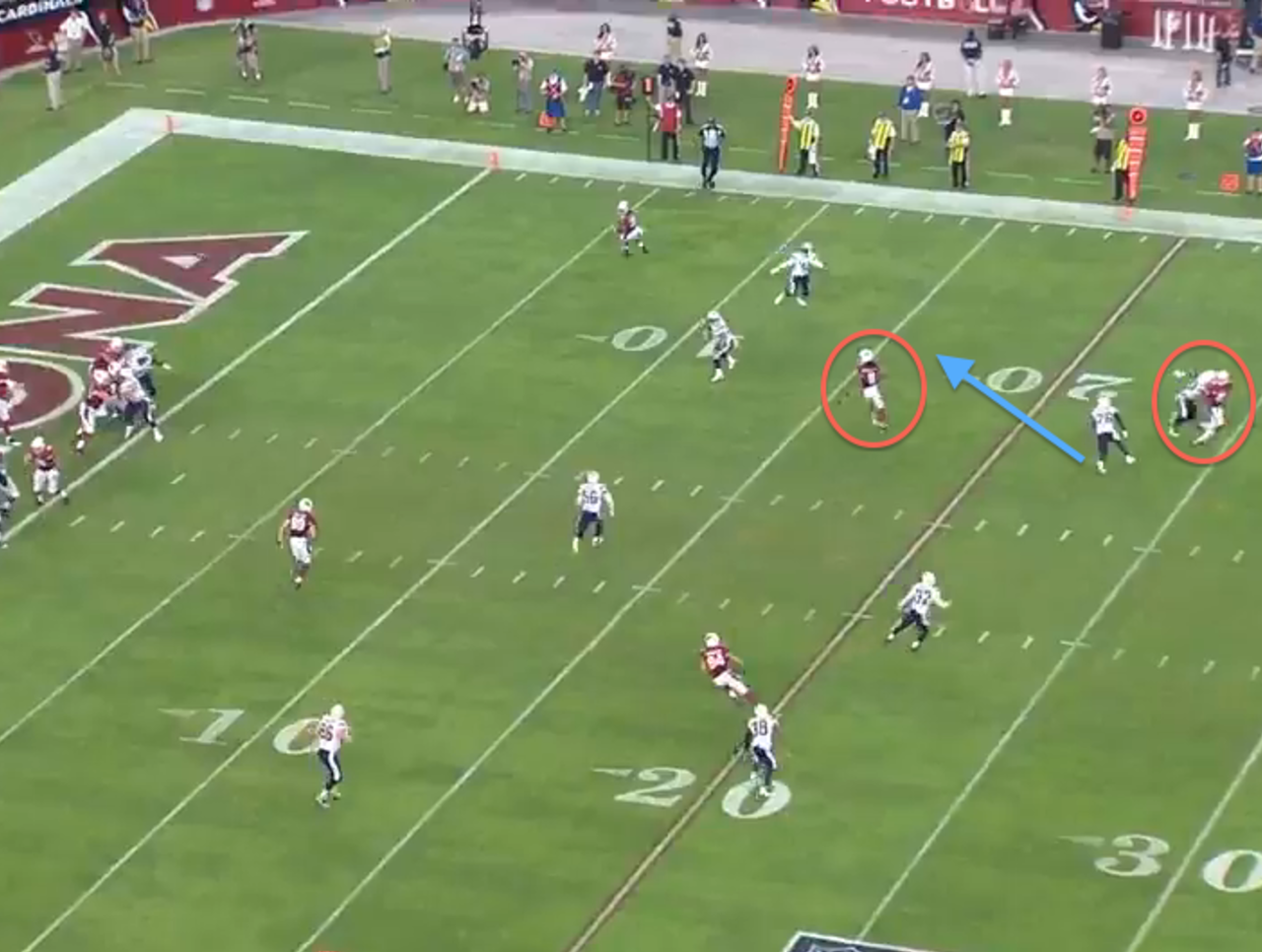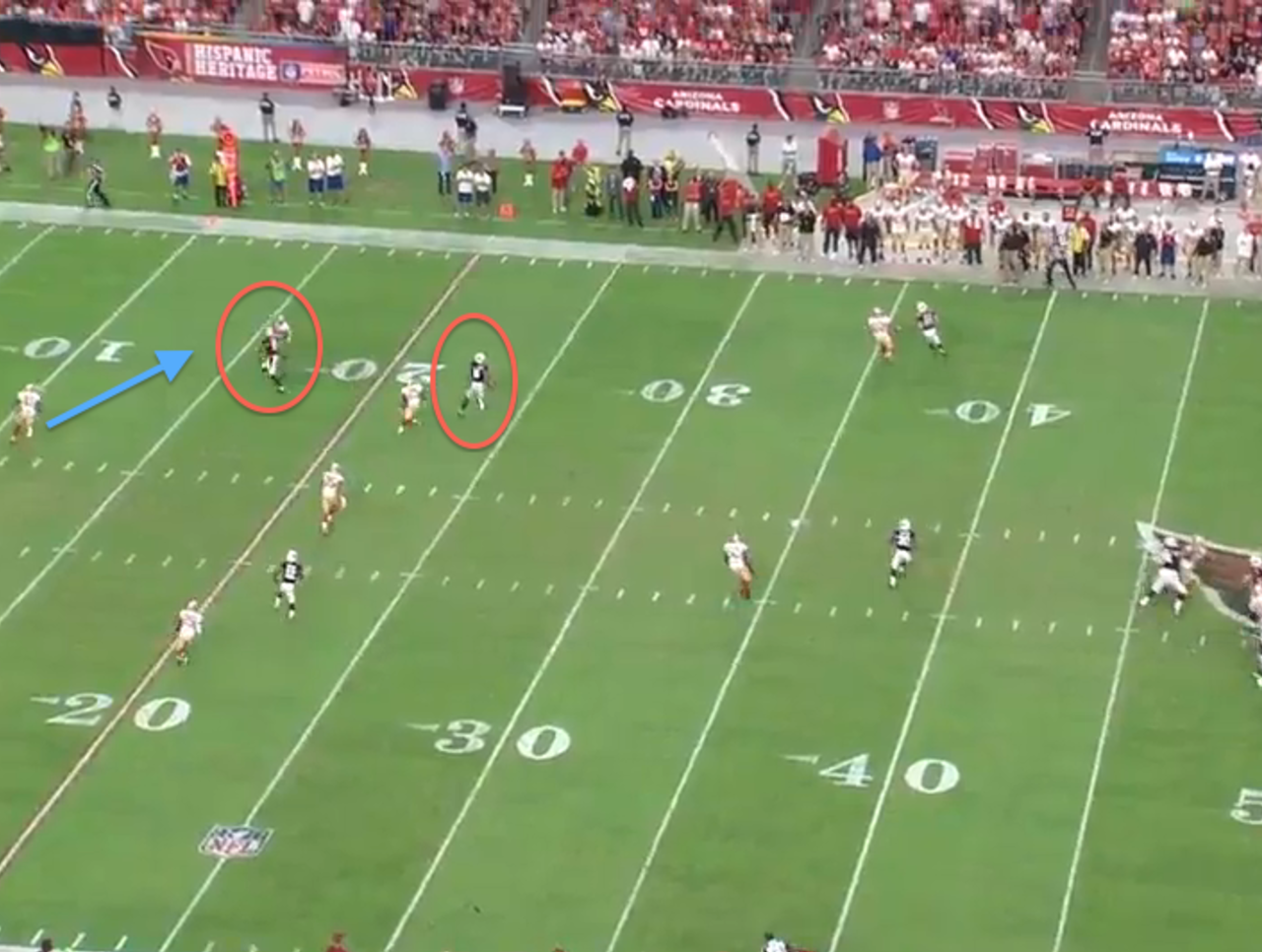Film Room: Schematic adjustments key to Cardinals' passing game
Here’s the thing about football: it’s systematic. Players stick to a regimen instituted by their coaches.
At specific times of the day, they are shot up, taped up, warmed up, played in specific defensive schemes that tell them where they should be against a specific offensive concept. And then there's an unexpected change.
Bruce Arians, the head coach of the Arizona Cardinals, is that change. He makes subtle offensive changes that throw defenses out of whack. That’s what makes him a good, strategic play caller. He doesn’t run the same concepts over and over. What he does is take the concept that he used weeks ago and, with the defense in mind, alters it just enough to come up with a big play downfield.
In the season opener against the San Diego Chargers, the Cardinals attacked vertically in multiple ways. One way was a Hi-Lo concept. They’re exactly what you think: One receiver runs low, underneath, in front of the linebackers, while another runs high, behind the linebackers, in front of the safeties. It pulls the linebackers up and pushes the safeties back, creating a hole in between them.
On third-and-long, from their own 15, the Cardinals emptied their backfield and spread out their weapons: Three receivers, one back, one tight end. One of the receivers was rookie third-round pick John Brown. Brown’s speedy and excels on deep routes. He was the first receiver of a stacked set that had Larry Fitzgerald, the second receiver, behind him.
Fitzgerald ran a shallow cross underneath, forcing the strong safety to come up further than he already had as part of the Chargers’ double safety rotation to Cover 3. That meant four underneath defenders and three deep ones. Standard zone coverage. When the strong safety came up to Fitzgerald, he left a void in coverage behind him, where Brown came in and ran a dig route.

The throw never came to Brown. Instead, it went to the tight end for 20 yards. What was more important than Brown getting thrown the ball was showing future opponents what the Cardinals’ concepts are. Arians was dangling bait.
Seven weeks later, the Cardinals faced the Philadelphia Eagles and pulled this concept out of their pocket again. The Eagles defense anticipated it and were thought to be prepared for it.
It was third-and-5 and, again, the Cardinals were backed up in their own territory. They were at their own 25. They lined up in an empty set, like they did against the Chargers, spreading the Eagles out with three receivers, one back and one tight end. Brown was on the far left again in a stacked set, this time with the running back behind him.
Brown released first and ran vertically, while the running back released underneath. He ran a shallow cross. The Eagles were in Cover 3, a single-high safety cheating to Brown’s side, waiting for the dig route.

As Brown passed a linebacker, he turned his shoulders and leaned in. The safety saw the move and opened his hips up to his left. As soon as he did, Brown squared his shoulders up and darted downfield again. In an attempt to keep up, the safety looped out and around. He didn't have a chance. Brown sprinted downfield and caught the ball over his shoulder for a 75-yard touchdown.
Arians’ slight adjustments are difficult to defend because there are only so many ways defenses can cover. The stack and bunch sets that Arizona’s play originates from forces defenses into simplistic coverages, which are used to avoid confusion on assignments. Additionally, it tips the Cardinals hand to the offense. Here’s another example from Week 1.
From their own 4, the Cardinals were in shotgun with only Larry Fitzgerald and Michael Floyd detached from the formation. They were bunched together inside the numbers.
The Chargers’ cornerback to the side was in off coverage. Two safeties stood deep. It was Cover 4, also known as Quarters.
What’s difficult about playing Quarters is the safety to the two-receiver side may be responsible for the second receiver in certain circumstances.
If the receiver runs less than a certain distance (i.e. 8 yards), the safety passes him off to the underneath coverage and doubles the first receiver.
If the second receiver runs past the 8 yards, however, the safety has to cover him, leaving the cornerback on his own. That’s the problem with systematic responsibilities.

Fitzgerald released inside, past the near defender, climbed more than 8 yards and cut outside to run a sail route. Concurrently, Floyd ran straight downfield, pushing the cornerback on his heels.
The cornerback thought he had inside help from the safety. With Fitzgerald running outside and essentially pushing vertically, the safety was forced to cover him. That left the cornerback outside on his own in a compromising position. Floyd blazed by for a 63-yard bomb before being tackled inside the opposite 40-yard line.
In Week 3, against the San Francisco 49ers, the Cardinals dialed up the same concept on second-and-30. They had Floyd and Fitzgerald to the same side, except they spread them out. Floyd was outside the numbers. Fitzgerald was in the slot.
Due to the simplistic formation, the 49ers played Cover 1 Robber, a man coverage with a zone spy underneath, thinking their cornerbacks could match up without problems.

Floyd ran vertically again, clearing out the cornerback covering him. His route drew the attention of the safety, too, who rotated over the top. With the two defensive backs cleared out, Fitzgerald beat the one-on-one coverage underneath, stemming the route straight and then inside, eventually breaking outside. When he did, he was wide open for a 24-yard catch that set up a manageable third down.
In the 2014 season, the Cardinals have 24 passing plays of 20 or more yards and five of 40 or more yards, per NFL.com. A big reason why is because of Arians’ knowledge of how static defensive schemes work, in turn allowing him to make subtle changes in his offense.